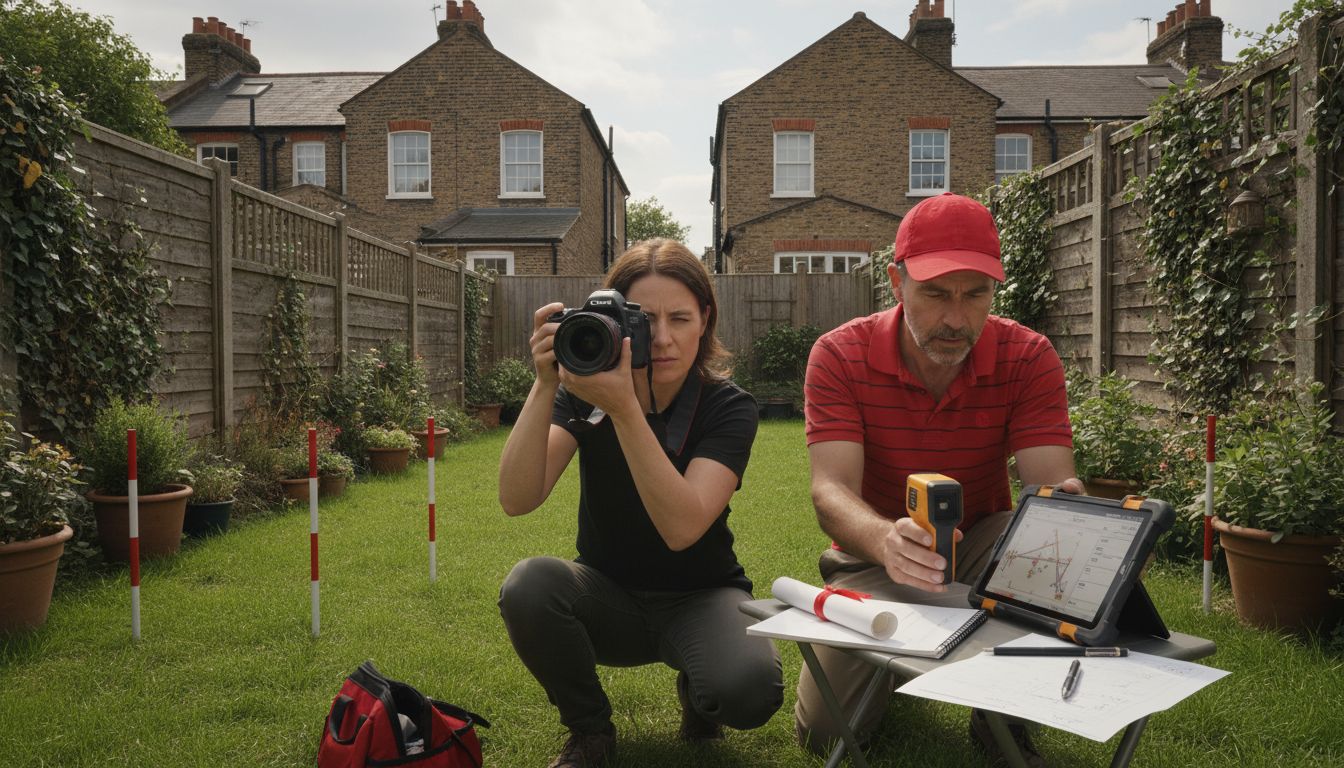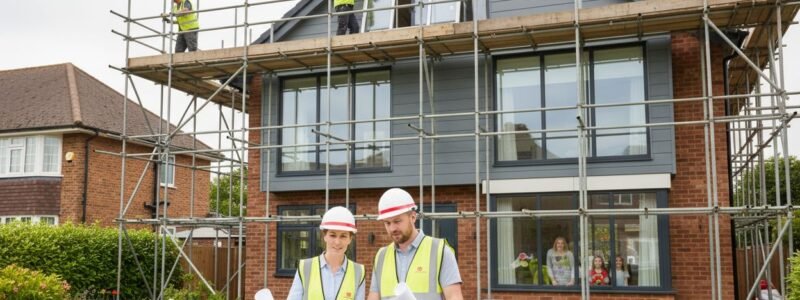Nearly 70 percent of London homeowners consider adding extensions to increase space or value, but many stumble over planning rules. Deciding if you need planning permission can be a confusing step filled with surprises and strict requirements. Understanding every stage of the approval process, from measuring your site to preparing detailed plans, helps avoid costly mistakes and unlocks a smoother path to expanding your home.
Table of Contents
- Step 1: Assess If Your Project Requires Planning Permission
- Step 2: Gather Essential Property And Project Information
- Step 3: Prepare Detailed Drawings And Application Documents
- Step 4: Submit Your Planning Application To Your Local Council
- Step 5: Monitor Application Progress And Respond To Feedback
- Step 6: Receive And Verify Your Planning Permission Decision
Quick Summary
| Key Point | Explanation |
|---|---|
| 1. Determine planning permission requirements | Assess if your home extension qualifies under permitted development rights to avoid unnecessary applications. |
| 2. Gather essential property information | Compile accurate measurements and documents, including surveys and previous planning permissions, to support your application. |
| 3. Create detailed architectural drawings | Prepare comprehensive plans illustrating the proposed extension, ensuring they comply with local planning guidelines. |
| 4. Submit your planning application correctly | Complete the official application form thoroughly and include all required documents to facilitate the review process. |
| 5. Be proactive during application monitoring | Regularly check your application status and respond quickly to requests for additional information to enhance approval chances. |
Step 1: Assess if your project requires planning permission
Determining whether your home extension project needs planning permission is the crucial first step in transforming your London property. According to the Planning Portal, many homeowners can undertake extensions under ‘permitted development’ rights without a full planning application, provided specific limitations are met.
To assess your project, you will need to carefully evaluate several key factors. First, consider the type of extension you are planning. Single storey rear extensions, small porches, and certain loft conversions often fall under permitted development rights. However, as research from HomeBuilding indicates, homes in conservation areas, listed buildings, or properties with previous planning restrictions will likely require formal approval.
Key considerations include the proposed extension’s size, height, and proximity to property boundaries. Most permitted development rights allow rear extensions up to 4 metres for detached homes and 3 metres for other property types. You must also ensure your extension does not cover more than 50% of the property’s original land area.
Here’s a summary of common extension types and their likely planning permission requirements:
| Extension Type | Usually Permitted Development | Typically Requires Permission |
|---|---|---|
| Single storey rear extension | Yes (within size limits) | Yes (if exceeds limits) |
| Loft conversion | Yes (basic dormers) | Yes (major alterations) |
| Porch | Yes (small size) | Yes (large or front-facing) |
| Two storey extension | No | Yes |
| Extensions in conservation area | No | Yes (almost always) |
| Works on listed buildings | No | Yes (listed building consent) |
Pro Tip: Always check your specific property’s planning history and local authority guidelines before starting any work.
If your proposed extension exceeds these standard limits, you will need to submit a householder planning permission application to your local council. This process involves detailed drawings, site plans, and potentially additional documentation about the proposed construction.
Next, you will want to gather all necessary measurements, create initial sketches, and prepare documentation to support your planning permission assessment.
Step 2: Gather essential property and project information
Before diving into your home extension project, you will need to compile comprehensive documentation and measurements that will support your planning permission application and ensure regulatory compliance. This crucial step involves collecting detailed information about your property and proposed construction.
Start by creating a thorough property survey that includes precise architectural measurements. You will want to measure the existing property footprint, current floor areas, and the specific dimensions of the proposed extension. Take careful notes about the current building structure, including wall thicknesses, ceiling heights, and existing architectural features.

According to Mammoth Builds, all house extensions must comply with Building Regulations regardless of planning permission requirements. These regulations cover critical aspects such as structural integrity, ensuring your extension meets minimum safety and energy efficiency standards.
Pro Tip: Hire a professional surveyor to guarantee accurate measurements and identify any potential structural challenges before proceeding.
Additional essential information to gather includes your property’s title deeds, existing floor plans, site boundaries, and any previous planning permissions or modifications. If your home is located in a conservation area or is a listed building, you will need extra documentation detailing the historical significance and proposed changes.
Next, you will move forward with creating detailed architectural drawings that illustrate your proposed extension, taking into account all the gathered information and regulatory requirements.
Step 3: Prepare detailed drawings and application documents
Creating comprehensive and accurate documentation is essential for a successful planning permission application for your London home extension. This stage requires meticulous attention to detail and a strategic approach to presenting your project to local planning authorities.
Your application documents should include professionally prepared architectural drawings that clearly illustrate the proposed extension. These drawings must show existing and proposed floor plans, elevations, and site location plans with precise measurements. Ensure the drawings are drawn to scale and include key details such as materials to be used, roof designs, window placements, and how the extension integrates with the existing property structure.
According to HomeBuilding, considering pre-application advice from local planning authorities can be a valuable step. This informal consultation provides early feedback on your proposal, helping you align your plans with local planning guidelines before submitting a full application. While this advice is non binding, it can help reduce planning risks and potentially streamline your application process.
Pro Tip: Include a detailed design and access statement explaining the reasoning behind your extension design and how it complements the existing property and neighbourhood character.
Additional documents you will need to compile include ownership certificates, agricultural land declarations, and a completed planning application form. If your property is in a conservation area or near listed buildings, you might need additional heritage impact assessments or specialized documentation.
Next, you will submit these carefully prepared documents to your local planning authority for review and assessment.
Step 4: Submit your planning application to your local council
Submitting your planning application marks a critical milestone in your home extension journey. This process requires careful preparation and attention to detail to ensure your proposal receives fair consideration by local planning authorities.
Begin by carefully completing the official planning application form, which you can typically download from your local council’s website. Ensure you include all required documentation, including the detailed architectural drawings, design and access statements, and supporting documents you prepared in previous steps.
According to HomeBuilding, most local councils process householder planning applications within an eight week timeframe. Professional consultants can be invaluable in navigating complex rules and improving your application’s chances of approval.
Pro Tip: Submit your application digitally through the Planning Portal to ensure faster processing and easier tracking of your submission.
When submitting, double check that you have included all necessary fees. Some councils require additional charges for site inspections or complex applications. If your initial application is unsuccessful, the research suggests you may have options to revise and resubmit your plans or launch an appeal.
For the most comprehensive guidance on navigating the house extension approval process, consider consulting with local planning experts who understand the specific requirements of your council.
Next, you will need to wait for the initial review and potential requests for additional information from your local planning authority.
Step 5: Monitor application progress and respond to feedback
Once your planning application is submitted, the waiting and monitoring phase begins. This critical period requires patience, proactive communication, and a strategic approach to addressing potential queries or concerns from your local planning authority.
Regularly check the status of your application through the online planning portal or by contacting your local council directly. According to HomeBuilding, most householder applications are processed within an eight week timeframe, during which the council will thoroughly review your submitted documents.
Prepare yourself for potential requests for additional information or clarification. Planning officers might seek more detailed drawings, additional context about your proposed extension, or clarifications about how your project meets local planning guidelines. Responding promptly and comprehensively can significantly improve your chances of a successful application.
Pro Tip: Keep all communication professional, concise, and well documented. Maintain copies of all correspondence and submissions.
As research suggests, if your initial application encounters challenges, you have several options. You can revise and resubmit your plans based on feedback, seek pre application advice to understand potential improvements, or in some cases, launch an appeal if you believe the decision is unwarranted.
Understanding the planning permission requirements thoroughly can help you anticipate and address potential concerns before they become significant obstacles.
Next, you will prepare to receive the final decision on your planning application and plan your next steps accordingly.
Step 6: Receive and verify your planning permission decision
The moment of truth arrives when you receive the official decision from your local planning authority. This critical stage determines whether your home extension project can move forward as originally planned or requires modifications.
According to HomeBuilding, most applications are processed within an eight week timeframe. As research from Extension House indicates, if your application is unusually complex, the council may take up to 13 weeks to reach a decision.
Carefully review the entire document when you receive the planning permission decision. Look for specific conditions attached to the approval, which might include requirements about materials, construction methods, or specific design elements. Pay close attention to any stipulations that could impact your original design or construction plans.
Pro Tip: Keep the original planning permission document safe and make multiple copies for your architects, builders, and personal records.
If your application is approved with conditions, you will need to work closely with your design team to ensure all specified requirements are precisely met. Should your application be refused, do not panic. Planning permission for extensions often involves negotiation, and you have options to revise and resubmit your plans or launch an appeal.
Next, you will prepare to translate your approved planning permission into actionable construction plans and begin the exciting process of bringing your home extension to life.
Take the Stress Out of Securing Planning Permission for Your London Home Extension
Navigating the complexities of planning permission can feel overwhelming, especially when local regulations and detailed documentation stand between you and your dream extension. The key challenges you face include understanding permitted development rights, compiling accurate surveys, preparing detailed architectural drawings, and responding to council feedback within tight deadlines. Without expert guidance, delays and costly revisions can easily disrupt your plans.
At Reltic Extend, we specialise in simplifying this journey by handling every aspect of the application process with over 20 years of experience in London and Surrey. Our dedicated team offers full support in Planning & Permissions for Home Extensions, ensuring your project meets legal requirements without unnecessary stress. Combined with our expertise in Types of Home Extensions & Ideas, we help you envision and realise a space that complements your lifestyle and property.
Don’t let the uncertainty of planning permissions hold you back. Act now to secure a smooth, transparent process guided by professionals who prioritise quality and timely delivery. Reach out today via our contact page and turn your home extension ambitions into reality.
Frequently Asked Questions
Do I need planning permission for my home extension?
Yes, many home extensions can be built under ‘permitted development’ rights without full planning permission, provided specific limitations are met. Assess the type, size, and location of your proposed extension to determine if planning permission is required.
What documents do I need to prepare for my planning permission application?
You’ll need detailed architectural drawings, a property survey, and supporting documents like ownership certificates and planning application forms. Gather these materials to create a comprehensive application package before submission.
How long does the planning permission process take?
Most planning applications are processed within eight weeks, but complex cases can take up to 13 weeks. Monitor your application’s status regularly to stay informed about any requests for further information.
What if my planning application is refused?
If your application is refused, you can revise and resubmit your plans or appeal the decision if you believe it is unjust. Review the council’s feedback carefully and address their concerns to increase your chances of approval in the next submission.
Can I submit my planning application online?
Yes, you can typically submit your planning application digitally through the Planning Portal, which can lead to faster processing times. Follow the portal’s instructions to ensure your submission is complete and accurate.
What should I do if I receive planning permission with conditions?
If you receive approval with conditions, carefully review these stipulations and work closely with your design team to ensure compliance during construction. Confirm that all specified requirements are incorporated into your plans before starting work.





